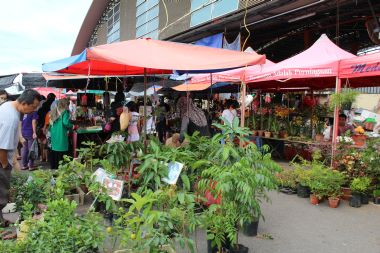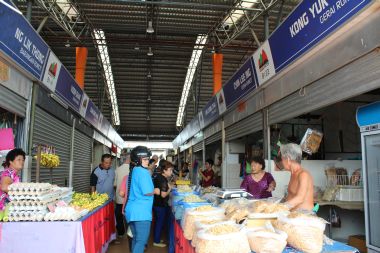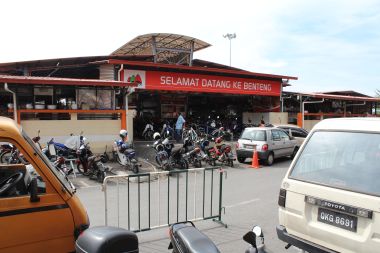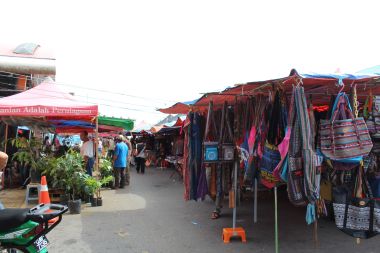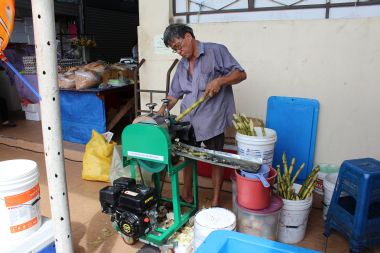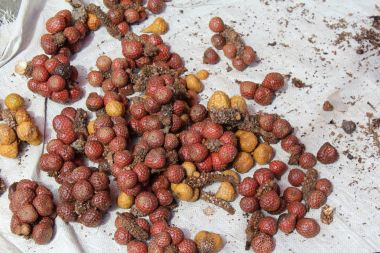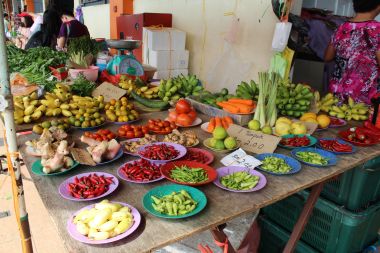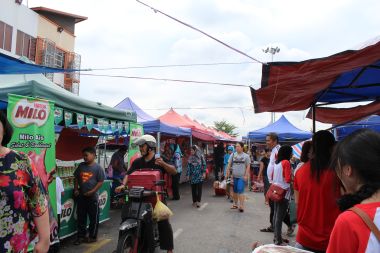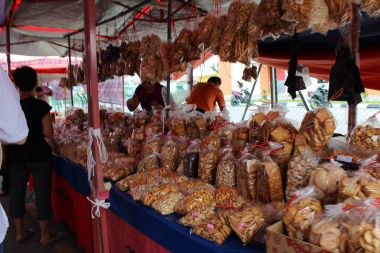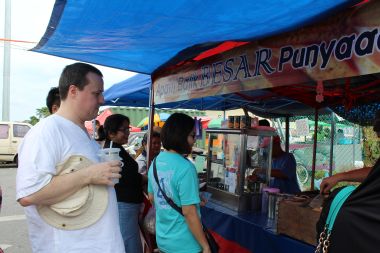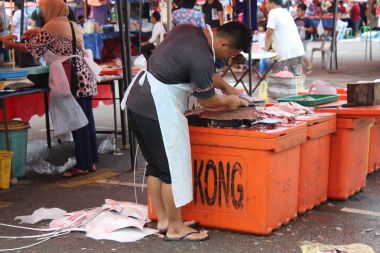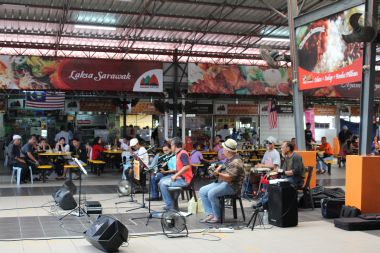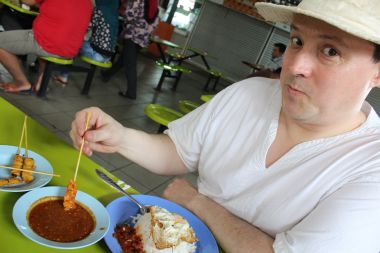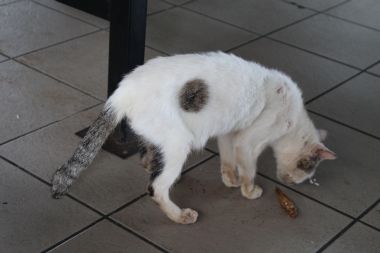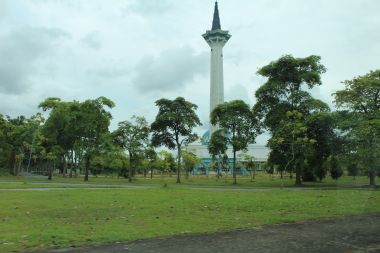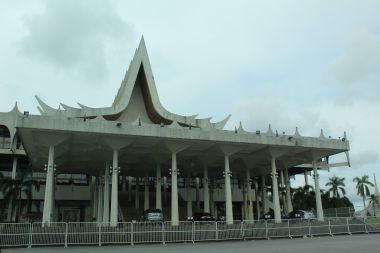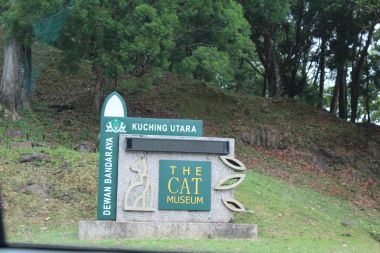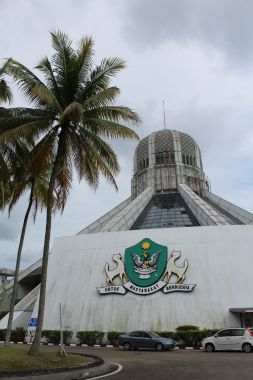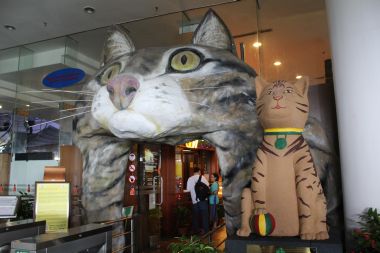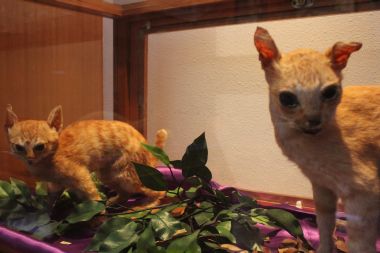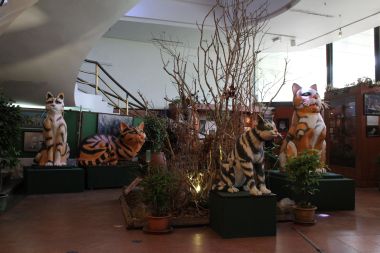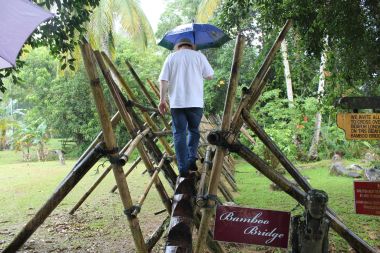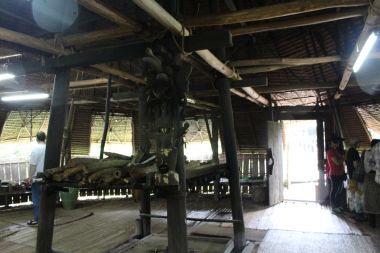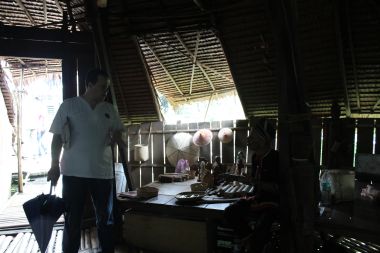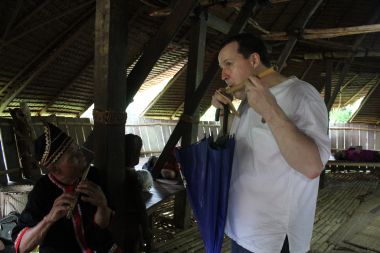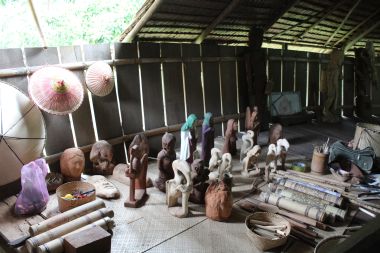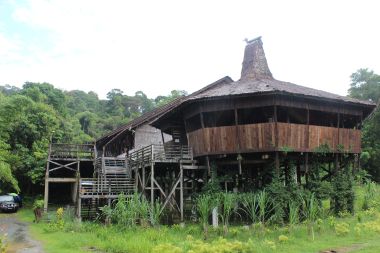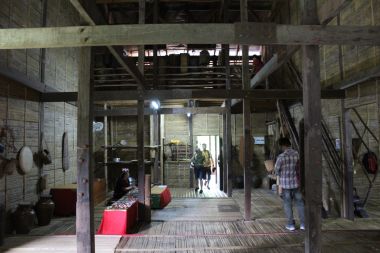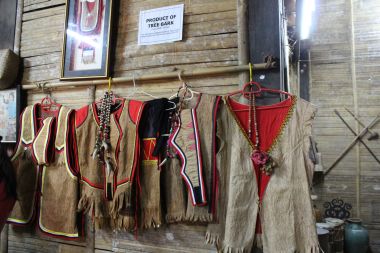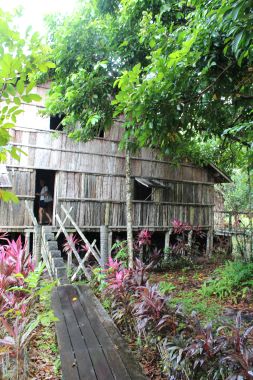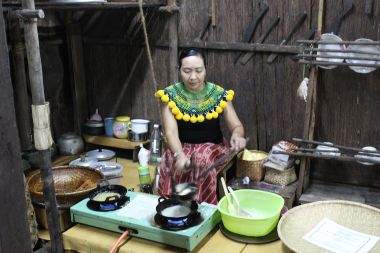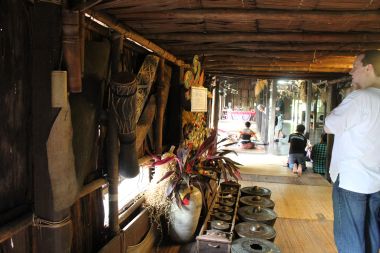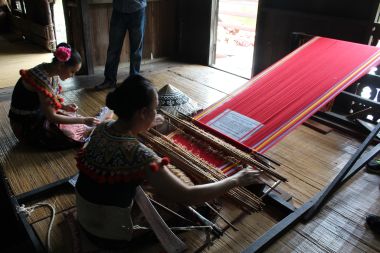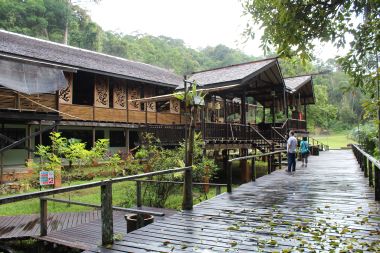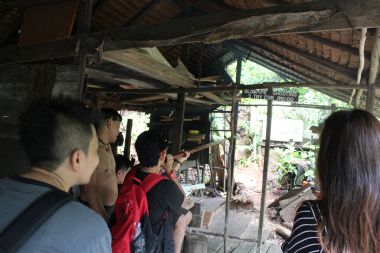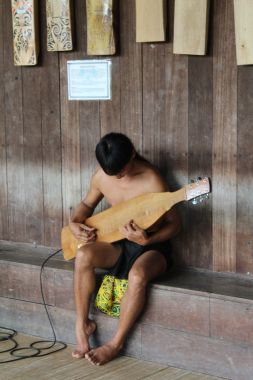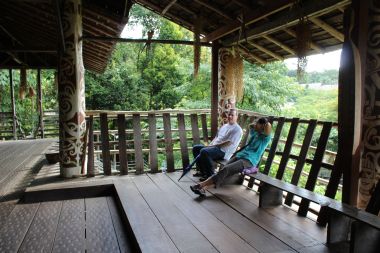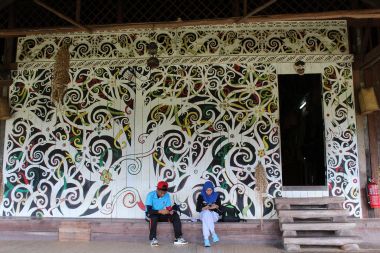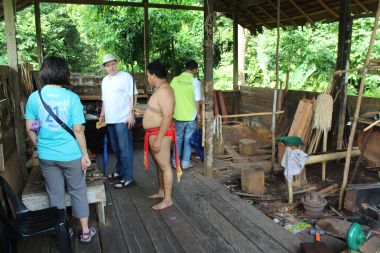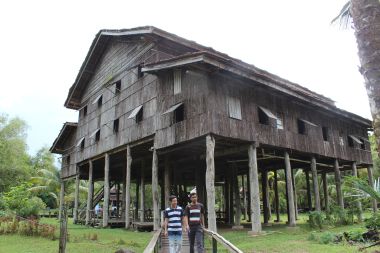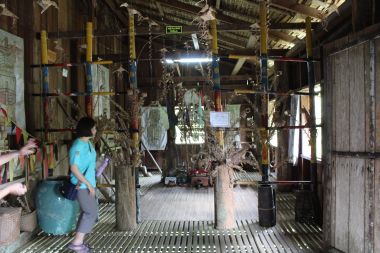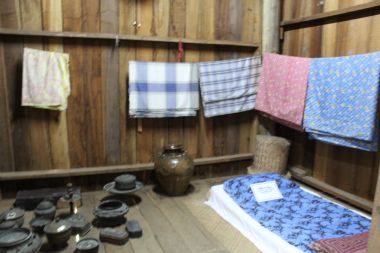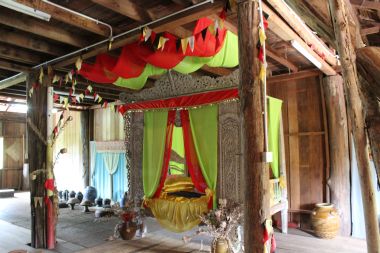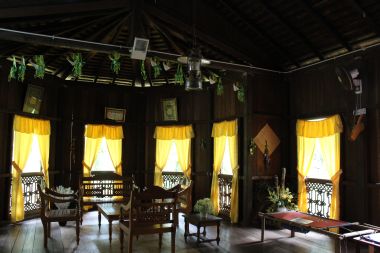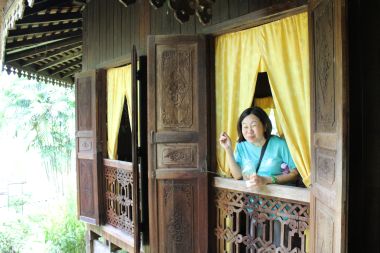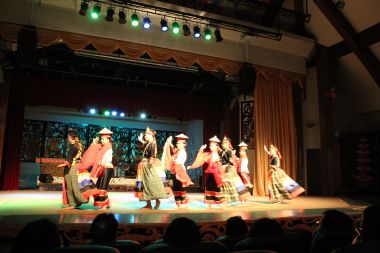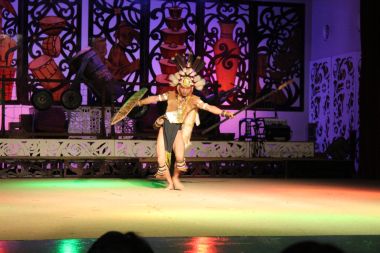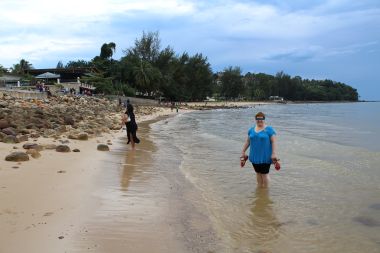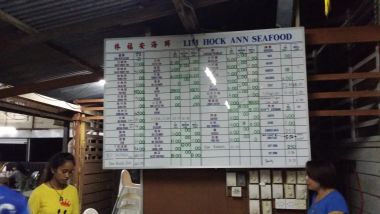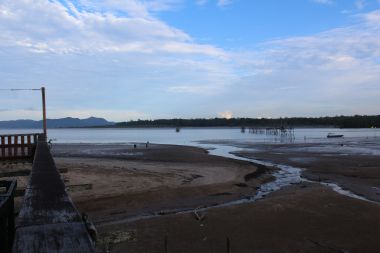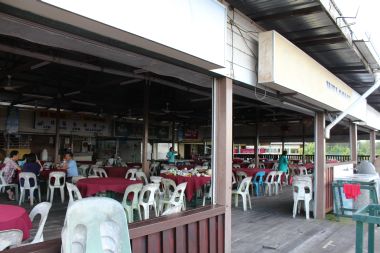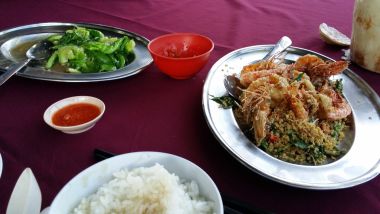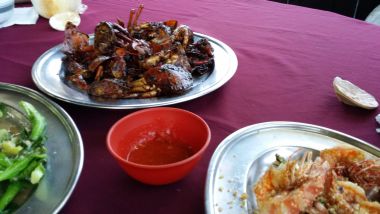Sunday, November 8th
Well, the phone kept me up a large part of the night. Silly, I know, but we are a long way away from things and it makes me feel a bit unsettled. Throughout the night I kept trying to get it to connect to one of the many local networks that I could see but it refused to use. Ok, the cold also had me shivering a fair amount as well…Not a very relaxing night by any stretch.
When we eventually managed to get up, have a shower and go downstairs it was about 9:30. Sian was long since up and she offered us some lovely small, sweet, bananas and, some more bottled water.
Sian suggested we might want to meet her parents so we put on our sandals (I have mine from Africa which are very strong and Mel has some rather fetching red leather ones) and headed out. Her street is a dead end with her house two in from the connecting street and her parents’ house is at the end, a few houses down. Her father is retired but was a watchmaker and invested wisely in several properties in the area including the house that Sian lives in now. Sian’s immediate neighbour has a shrine in their front patio so we can smell the incense as we walk through her electronic car gate and down the street. She has a papaya tree that is only about five or six feet tall and a pineapple plant at the bottom that she planted just outside of her gate which Mel thought was quite interesting (having lived in Africa it was not entirely new to me). The pavement is a bit broken up on the street with the houses on either side. Everyone has quite nice cars and most of them have satellite dishes as well. Sian’s parents’ house has a modest garden that comes out the front, along the side and back that is crammed with plants. Her father has a series of “bonsai” long the front wall (I say “bonsai” as these are the largest “bonsai” I have ever seen) but there is also a large garden of flowers, fruits and vegetables. Sian was keen on us trying one of their papayas as the particular variety they are growing is supposed to be quite sweet but, unfortunately, her parents were not in - Probably out having coffee and/or breakfast.
We headed out for breakfast. Today she took us to an area that used to house the weekly market where we visited a small Indian restaurant serving up Indian flat-bread, as far as I can recall, “chapattis” that were served with various toppings including sugar and simply butter. These were being made fresh by a man with a hot plate standing near the entrance and were incredibly cheap starting at 1 ringgit (16p) each. They also had a small buffet of various curries but we were here for the chapattis. They were absolutely delicious and likely terribly unhealthy being drenched with butter. We had tea on the side which, evidently, means “English” tea here so I had better be careful as it is not really my favourite.
Despite being the only foreigners in the restaurant we were left to ourselves though when we arrived there was no seating so we sat down with a solitary older man eating who then promptly left…felt a bit guilty about that but there seemed to be no problem…As we left I forgot our rucksack in the restaurant but one of the patrons raced after us to return it. Not sure that would happen in the UK.
As we have been driving around this morning and last night I noticed that most of the street restaurants are, perhaps unremarkably, open to the outdoors and occupy the space below buildings, much as any shop. The entrances are often covered with large advertising banners that you push aside to enter. This is obviously to keep out the dust, and heat.
Mel and I had little local Malaysian currency with us so it made sense to stop at a bank machine to pick up some particularly in light of my sleepless night worrying about it so Sian pulled into a strip mall off of the road so that Mel could get some money from a bank machine (going for 500 ringgits (£78) though at the rate at which Sian is paying for everything I am not sure it will be used…). While Sian and Mel did that I noticed that there was a 7-11 just down the road…Readers of my journals may recall that I have a bit of a thing about an iced soft drink provided by 7-11s the world over: Slurpees. In my opinion it is not a real 7-11 unless it has a slurpee machine. Thankfully this was a REAL 7-11 (though, sadly, only two very sweet choices of drink) so I quickly grabbed a cup and started to serve myself…only to find the machine was acting up. The helpful attendant came over and filled the cup up for me. Mel and Sian eventually came by and we had a bit of a laugh about the whole thing ending up with Sian taking a picture of me and Mel standing in front of the Slurpee machine.
What can I say? I have a bit of a problem…perhaps.
To be honest, the Slurpee thing is all in good fun and a bit of silliness, giving us something to look for and explore in the places we visit. It is also a great icebreaker with the locals.
The weekly (Sunday) market has moved to a dedicated site a fair way away from the old location. Sian has never visited but her mother has talked about it so we headed out to have a look. As we approached the site along the river we could see it was absolutely massive and crawling with vehicles. We eventually parked in a dirt parking area on the other side of a busy road (crossing against the light and with not a little bit of fright dodging the traffic) and walked into the market.
All around the market is a crush of cars and people but no one appears to be in too much of a hurry. A small road leads directly through the market which we followed on our visit. The road is jammed with cars, motorcycles and small trucks moving very slowly and people walking, generally much faster, in amongst them. Stalls line the right side of the road and there is often little more than your body width between the stall and the car that has decided to pass you.
On entering the market there are a series of large covered buildings on the right of the road that have many more stalls arranged into aisles. These have only been open for a short period of time and one is actually still under construction - putting more pressure on the crowded road. On the left of the road near the entrance is a smaller covered building that is actually an eating area that we would visit later.
First we came across the gardening area of the market with wonderful looking plants mostly exotic to our eyes but a few familiar items in amongst it. The collection of aquarium fish was of interest to me having always had one while I was growing up with many of the varieties here familiar to me but some quite exotic.
We watched a man pushing sugar cane through a machine to make juice so Sian bought us some - Not as sweet as you might expect but refreshing. At another stall they were selling fresh coconuts that they would chop off the top for you to drink out of along with a spoon to carve out the flesh. To the side of the stall were large stacks of empty coconut shells.
One the specialities of the region is “Sarawak layer cake” which is a very dense cake that has colourful layers or even designs in it. Sian indicated that the cakes for sale in the market were possibly imported from elsewhere so not really “Sarawak” at all but possibly from as far as Indonesia to the south. We tasted some of it but it was not anything too special to us…but they looked amazing anyway. They come in various flavours as well.
As we slowly followed the road towards the back of the market we stopped at each stall to see what was on offer or, more often than not, to ask Sian what exactly it was - particularly the odd looking snakefruit but we also saw the not-so-unusual mango, plantain, bananas (though an unusual number of varieties), pineapple (who knew there were many varieties of this - we saw the typical shaped ones but also ones very long and skinny), hot peppers (many varieties both fresh and dried) and watermelon as well as the very unusual rambutan, and jackfruit.
Behind the main market buildings is a large open area with rows of stalls covered in plastic to keep out the relentless sun.
Here we waited for a few minutes while Sian ordered from a stall selling, essentially, peanut pancakes - A batter is spread out on a circular griddle to cook for a few minutes then a peanut paste is added to the top then it is folded and served in a paper cone. Very hot. Very tasty. It was interesting just to watch the man making them - So quick and good at what he does day in and day out.
The queue for the pancakes was actually quite big so we had to wait quite a while before being served so while Sian was waiting Mel spotted in the adjacent tent a man filleting large rays (fish). Though slightly gory it was amazing to watch him preparing this fish we only rarely have ever seen eaten (or even alive) - The long tails (up to two feet on some of them) was cut off then he would gut the main body of the fish. He did not seem to mind as Mel took a number of pictures, indeed, no one in the market seemed to mind us taking pictures so Mel snapped away throughout the morning.
Having walked the length of the market we returned to the entrance to have a bit of a meal in the small food court since all we had been doing up to now was really just snacking. Sian was determined for me to try “Nasi Lamak”, the national dish of Malaysia, so she went off in search of that. The food court is a big covered building with food stalls all around the outside with a large open area in the middle with tables and chairs. Today there was also a band playing local music with what looked like very little enthusiasm.
It was not very busy when Sian returned to the table with some satay chicken skewers (with a large amount of very tasty sauce to dip it in served in a bowl) then a few minutes later the “Nasi Lamak”, freshly cooked, was delivered to our table. It is really a breakfast dish so I think she had to convince a stall owner to make it for us at what have been midday. It is a pile of rice with a fried egg on top with some hot sauce and a small fish on the side of the plate. That is about it.
The sauce was very fishy and a bit spicy but the dish tasted alright. Mel figured that the cats would enjoy the fish more than me but even though they looked quite skinny and malnourished they seemed to have their standards and left it on the floor.
A lady walked up the band and picked up the microphone to start singing along using her phone to display the lyrics. Did not faze them.
Next Sian drove us around the various government buildings in the city. This is, after all, the capital of the region. There seems to be a lot of space here with large planted central reservations in the roads and massive gardens surrounding what are, for the most part, modern and interesting looking buildings. All of these parks seem to be maintained impeccably - I guess it has to look impressive. We passed by the “Sarawak State Mosque” with its tall spire making it visible from miles around as well as the “Sarawak State Library” on a small lake, the “Sarawak Electricity Supply Corporation” building juts out of the ground adjacent to a roundabout like something out of Blade Runner, the “Menara Pelita” office building looks similar to the Lloyds bank building in central London but more modern and the pièce de résistance being the massive “Sarawak State Legislative” building that sits on the edge of the river resembling something like a massive traditional round house with sweeping lines, glass and gold.
Having shown us the government buildings as we drove around we convinced Sian we wanted to visit the cat museum. Now, I have said something about cats already but there is something about Kuching that means it is very specific to cats in that the word “kuching” is very similar to the word for cat in Malay (“kucing”) so the Kuching city coat of arms has cats on either side (and there are statues to cats in the city as well). So one of the tourist draws to the city is the cat museum.
Sian told us that originally this was in a smaller building in town but now it sits atop a tall hill in a magnificent building offering tremendous views of the surrounding countryside.
Parking the car around the corner, we took some pictures and entered into the building that was originally used for some government agency. It was rather like a government building as we entered the quite clinical interior. Following the paw prints we could not mistake the entrance to the museum - a giant cat head - we passed through it’s mouth to purchase our wristbands and explore.
To be honest, I was still very troubled by the banking situation so I spent ten minutes on the free wi-fi to try to figure out why I could not get any network signal - with no luck. Mel and Sian began taking a look around starting with some stuffed cats that Mel said looked a bit…horrific (looking at her pictures I tend to agree).
The museum is really quite a complete view of everything to do with cats - Posters, books, pottery (including cat idols), toys, paintings, as well as displays discussing various aspects of cat life including health and the different breeds. It is quite well done and thankfully, for us, all in English. There is a group of people that are very passionate about these furry pets that put this together…it was quite amazing. I particularly enjoyed one section about plays and musicals about cats (including the obvious) and another section about the different breeds.
Having had our fill of cats we left the museum to see that in front of the building was a traditional Malay house - A simple square structure with big windows.
The view from where we were was amazing so we took some time to take it in. Many of the mountains in the near distance are tall plinths rather than the traditional conical or flatter shape than I have ever seen before. All of the mountains are just covered with trees and Sian indicated that many she has climbed before following local hunter paths up to the tops.
It was starting to rain so we returned to the car just in time to see a tour bus arrive so just in time to head out. Continuing back down the hill we noticed two intrepid tourist hikers climbing up the rather steep incline. Here there are a lot of hikers and the more athletic type of tourist. We applauded them as we drove by comfortable in our air conditioning as we headed out of the city.
Sian drove us out of Kuching for quite some ways along very well maintained roads. The city slowly dropped away with the trees and mountains taking it’s place alongside though there always seemed to be a hut here or a small village there. Eventually we arrived at our destination - The “Sarawak Cultural Village” (Kampung Budaya Sarawak; http://www.scv.com.my/) which is opposite a resort complex (the “Damai Beach Resort” and “Damai Central” leisure complex) on the ocean.
Driving around for a few minutes we eventually found a parking spot and dashed through the rain to the main entrance - Sian had very thoughtfully brought with her some spare umbrellas. The wooden entrance arch has a somewhat incongruous digital sign attached to it announcing its presence but this was a bit of taste of what was to come. Sian had a discounted entrance ticket but we insisted on paying our own admission which were actually fairly expensive compared to the prices we have been seeing - 60 ringgits each (about £9).
The village consists of groups of buildings representing the major indigenous groups from the various regions in this part of Malaysia. Each group has people occupying the buildings and talking about their culture, often playing instruments, cooking or simply talking to the tourists walking by. All of the people here are dressed in their traditional costumes and the buildings are set out largely as if they were currently occupied. On paying our admission we were given a “passport” with a page for each of the groups to have stamped as we made our way around the village.
We started by crossing a traditional bridge that consists of a narrow walkway of bamboo with railings of bamboo arranged at an angle. Of course, I had to give it a go - health and safety be damned. You walk along the narrow strip of bamboo and periodically grab onto the railing when you feel you might slip which was quite often given that it was raining and we were holding umbrellas in one hand. It was quite a length and in due fashion passed over a small river.
We entered into the “Bidayuh Longhouse” which was a large round bamboo single story building raised quite some distance above the ground on stilts. In the middle of the circular room was a fire pit with a rack above it containing some human skulls.
Talking to the gentleman carving wood in the corner (and trying to sell us some) he indicated that the skulls are of warriors who, when they die, wish to remain with their community so consider it an honour to have their bones stored here.
Along the walls there is a wide ledge that had several people sleeping on - it was, after all, the heat of the day though a lot cooler with the rain. He insisted on my trying one of the flutes he had carved but of course I had no luck getting out even a peep.
So, you might ask, what is a “longhouse”? Here they use the term to refer to basically a village on top of a high bamboo platform. Walking along the platform there are buildings on each side where people live sort of like what you see in a motel. The raised platform, I believe, keeps the buildings cool as well as keeps out the animals and insects of the forest below. The longhouse is, of course, a traditional communal way of living for many of the people here.
The village is surrounded by green, lush forest as well as mountains looming in the distance. The plant life is quite staggering and in the rain it was quite peaceful walking between the buildings to see what each had in store for us.
We left the traditional Bidayuh longhouse by an elevated wooden walkway then entered a newer version that was up a double staircase and had some performers relaxing after their show. Again, it was a large circular building with the fire pit in the middle. This building had brightly coloured cloth lining the ceiling which made it feel a lot brighter particularly as we were also up higher and all of the windows being open to let in the sun. We did not have enough time to wait for the next show so continued on after taking some pictures of the carvings and gongs. There are cats everywhere here too so Mel took a number of pictures of them as we made our way around the village.
The longhouse part of the Bidayuh area was our next port of call where rather than seeing the ceremonial buildings we were able to see into how the people actually live. The rooms (houses) off the central platform were quite spacious with massively high ceilings (presumably to keep them cool).
We saw the clothing the Bidayuh are known for make out of bark (from the “Artocarpus Odorattissimus” tree, don’t you know) that were being sold in the small gift shop - The stall owner was only too happy to explain what things were and point things out to us - Very friendly. Leaving the tall platform of the Bidayuh longhouse behind we passed alongside a small shrine which is typical of this village - Yes, it is a bit touristy but they have gone out of their way to give you a sense of the authentic. It is artificial in the sense that this is a tourist attraction but they have kept things as real as possible.
Our next visit was to the “Iban Longhouse” which is just on the small lake around which the village is arranged. It was much lower to the ground and more of an actual community than what we had seen with the Bidayuh. Entering was a bit tricky as we had to walk along a perilous set of steps carved out of a log. Of course, we could have walked around to the side where there were sensible stairs but where is the fun in that?
Inside one of the houses were two ladies cooking - One making a stringy donut-like concoction that was made by putting some batter into a ladle with narrow holes in it suspended from the ceiling over top of a small pan filled with extremely hot oil. As the batter drizzles out of the ladle it forms into cooked strings in the oil.
In the other corner another lady was making a similar fritter but this time using what looked like a branding iron for cattle but with a flower pattern at the end that she put into the batter then dunked into the hot oil. After a few minutes the batter is cooked and falls off the form into the oil. The skills of both women, who have obviously being doing this for years, was quite impressive as they churned out more and more of their fried treats while we watched. Of course, both of the snacks were also for sale.
In the communal area there was a “warrior” dressed up who was stamping our passports and on the opposite side was a lady sitting on the ground with a rather complicated contraption she was using for weaving (“Tenun Karap”). The designs she was making were incredibly intricate and how she was able to keep the hundreds of threads in the correct position I will never know - Quite a skill. Evidently this is a traditional housewive’s “recreation”. They are taught the simpler patterns at an early age then gradually, at the age of about 14, work their way to the more complicated patterns that were being demonstrated to us. All of the ladies in the Iban area had a wonderfully coloured scarf around their necks rimmed with red tassels - Very pretty.
“Dewan Lagenda” was a performance hall that was unoccupied when we visited but was interesting with all of the intricately carved wooden panels covering the sides.
Next was a visit to a tribe, the “Penan”, that seemed a lot more primitive using a blowpipe for hunting. Their small hut was in the middle of the trees and they were offering people a go at using the blowpipe to blow small darts into soft drink cans (yes) at about 12 feet.
Passing through here we were able to follow a series of wooden walkways to a small waterfall where we were able to rest for a few minutes before continuing on.
The “Orang Ulu” longhouse is another built quite high up on stilts so there were lots of stairs leading up with the added complication of the last bit being a rather long log carved with steps in it. In the communal area here we made use of some seats along the edge that looked out over the rest of the village and listened to a man playing a traditional carved instrument like a slender guitar. We laughed as we realized he was playing Christmas songs! It seems so out of place here. He laughed along with us but was quickly distracted a large group of tourists came over to talk to him.
The walls were lined with the various stages of the instrument as it is being made from the blank to the final product. It sort of resembles a cricket bat though with a hollow back end I am assuming for resonance. The walls and pillars of this longhouse are covered with an amazing intricate whirly pattern. Many of the other buildings we have seen were not so well decorated so this is quite nice to look at.
Inside one of the houses here Mel was momentarily distracted by the tattooing equipment on display - Evidently the woman of the “Orang Ulu” tribe are the ones that are traditionally tattooed using the standard “stick with a pointy bit of metal” method of application taking almost a week before the swelling goes down. Obviously very painful as maidens will have tattoos around their wrists but even worse for the chief’s daughter who might have her forearms, hands and legs decorated as well!
Continuing on we stopped another building where there were blacksmiths making swords and carving wooden objects. They demonstrated to the visitors how they make the rather neat looking wooden “trees” we have seen everywhere - A stick of wood is shaved with a sharp blade but the shavings are left in place so it becomes quite “feathery”, like a tree (they were for sale here too, of course). I took a few minutes to talk to one of the men who was wearing not much more than a loin cloth which must be a bit of a bonus when working with the incredible heat given off by the furnace.
The “Melanau tall house” certainly lived up to it’s name and was the most impressive structure here. The stilts holding it up must be about two stories high with several flights of stairs to get into the building.
Inside were the standard exhibits that we have begun to expect here.
I made my way up to the second level within the house to look at the rooms where people slept - Simply a mattress on the floor with a small pillow. The sleeping rooms here again have tall ceilings but are all in the middle of the building so do not have windows. This seems more of a single building with a lot of people living in it as opposed to the longhouses we have been seeing.
The top floor had the most elaborate with a lavishly decorated four-poster bed on one wall.
The views out of the windows up here were quite good as well looking out over the lake and the surrounding woodland. Getting into the upper floors was a bit tricky as you have to climb those carved logs again at quite an angle and length - Going up was easier than going down, for sure.
Mel and Sian talked to the host for quite some time and I inadvertently “photo bombed” some other visitors when I stood in a doorway to listen as well…The “Malanau” certainly have a lot of crafts - Pottery, paintings, carvings and metal pots.
The back of the Melanau tall house was a small hut processing “Sago” (the starch from the pith inside palm stems) into sweets. Another hot thing to be doing in an already hot environment…We did actually purchase some sweets a bit earlier but we did not think they were not really all that nice tasting.
Next we visited the “Malay townhouse” which seemed quite Indian (as in India) to me. We were asked to remove our shoes and the main part of the structure was a shrine then at the front was an elaborate sitting area that would not be out of place in an English manor house. More sweets were being made at the back…food is a big part of every culture it seems.
The final building to visit was part of Sian’s cultural heritage - The “Chinese farm house”. When the Chinese first came to Malaysia they set up farms and this was quite a crude and basic building compared to the elaborate structures we had seen in the rest of the village - Corrugated iron roof and white-washed flat walls thought this was obviously to show the practical side of the way the Chinese lived here rather than the domestic side.
It was now quite late in the day, 4 pm (the village closes at 5), but we had planned it well so that we were able to go see the show that happens twice each day. We waited for a few minutes outside of the theatre before being shown in. Wow. It is a large, modern, theatre that was incredibly cool to us with its air conditioning after having spent the day in the humidity and heat.
For the next 45 minutes we had dancing and music from many of the groups represented in the village.
The highlight had to have been the blow pipes of the “Penan” people - The warrior invited a volunteer from the stage to give it a try popping some balloons attached to the wall on one side of the stage. After a few misses he eventually had the blowpipe right up against the balloons - Success! Of course, his success was much better with only a single miss from about 30 feet.
So, generally, the village is a bit contrived but very interesting and very well done.
We left the village to go have a look at the ocean near the resorts. Passing by another statue of the rarely spotted hornbill Mel and I headed right down to the water, taking our shoes off to dangle our toes in the ocean.
The small beach here is quite rocky with only a few swimmers. We ended up walking along the path past a small bar only to come to a locked gate that leads on to the private resort here. At that point the beach becomes a bit better with actual sand…
The public area has a around area with various shops and businesses around the outside (including, you might be pleased to know - or not - a 7-11 though not sure if it is a “real” one or not, we did not investigate). Sian was keen to show us inside a back-packers style accommodation (“BB Bunkers Hostel”, http://bbbunkers.com/) that consists of a single room containing beds on the ground level and an upper level that is accessed by stairs. All of the areas are sectioned off for privacy using sheet dividers. The owner was there and Sian was able to talk him into letting us have a look in. Very clean and looked to be quite comfortable.
We piled into the car exhausted from all of the walking and standing we had been doing to return back to Kuching. Sian knew of a place on the way back to the city that we had to stop at for dinner - the fishing village “Kampung Buntal”. It is a small village off the main road back to the city but it is well known for two “restaurants” (though they were more like a limited hawker market with several vendors at least in the one we visited). We drove through the narrow roads to come up to a large cleared area that was the car park. Obviously they cater to large groups of tourists.
The restaurant we visited (“Lim Hock Ann Seafood”) consisted of a large elevated covered seating area with about 30 tables built above beach open on all sides that looks out on the ocean and the fishing village itself.
The decoration is quite basic here with plastic garden furniture used for the chairs and tables. Each table sat about five to eight people but when we arrived there were only one or two tables with people in the whole place.
It took some time to get the attention of someone to take our order but eventually Sian asked what we would like and made her choices. Eventually the food started arriving (yeah, hold back, some more description of food - hey, I like food!): We had smaller local crabs cooked in a wonderful pepper (as in peppercorn) sauce (Mel and I have problems with the shells of crab so although this tasted great it was very fiddly for us to eat - particularly these smaller ones), prawns with a sweet peanut coating (this was for me as Sian is not eating meat and Mel does not really like prawns - delicious but a bit tricky as I was told to eat the whole prawn which was still in its shell - I find this a bit difficult to swallow but gave it a go), then steamed Chinese broccoli (“kai lan”) served here with garlic (yum) and a dish of local fern greens (“Midin”) also served with garlic. The latter is quite interesting as it reminded Mel and I of the “fiddleheads” dish in Canada (young ferns that are still curled up about 2 inches in diameter). Served alongside was, of course, rice and a spicy dipping sauce. All very tasty.
It was a bit messy eating, particularly the crabs, but conveniently in the middle of the restaurant were several sinks where we could wash our hands.
By the time we left the restaurant it was getting quite busy and we saw in the parking lot a tour bus as well. It was dark as we returned to the highway. We got back to Kuching quite late at night and I spent some time admiring the Christmas lights on the street lights as we drove into town.
It has been a bit embarrassing tonight though as we have caused some trouble with the toilet that we have been using at Sian’s - You will recall it is a flushing Western-style one. Without going into too much detail, let us just say it no longer flushes so we have been forced to use the squat toilet on the main floor. We are SO embarrassed…
Anyway, hope I sleep better than last night but after such a packed day of activities I don’t think it will be a problem. Fingers crossed. Though we do have to get up early for the orangutan sanctuary…
